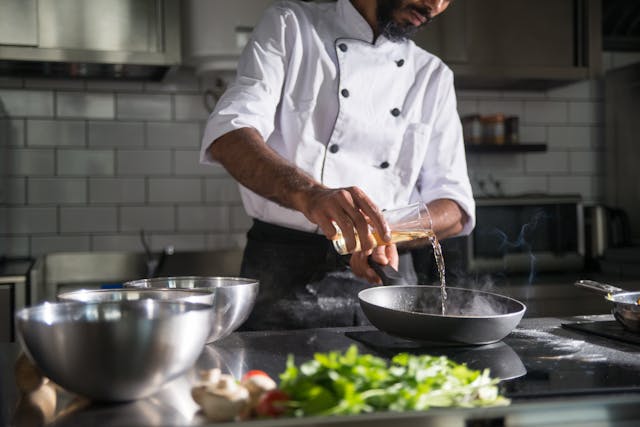
In the bustling environment of a professional kitchen, the chef’s attire serves not only as a uniform but as a functional tool that enhances comfort, safety, and efficiency. Among the most important elements of this uniform is the chef coat. Designed with both practicality and style in mind, selecting the ideal chef coat involves considerations ranging from fabric choice to fit and functionality. The right coat can contribute to a chef’s confidence and professionalism during service while ensuring they remain comfortable throughout long shifts. Each feature, from the collar style to the sleeve length, plays a role in optimizing performance and presentation in the kitchen.
Fabrication: Balancing Comfort and Durability
Chef coats are typically crafted from materials that prioritize both comfort and durability. Cotton and cotton blends are popular choices due to their breathability, which helps chefs stay cool in the heat of the kitchen. These fabrics also offer ease of movement, crucial for the dynamic tasks performed by culinary professionals. Polyester blends are another option, prized for their wrinkle resistance and durability against stains, though they may sacrifice some breathability compared to cotton. Nylon blends have also gained popularity for their lightweight feel and moisture-wicking properties, ideal for chefs working in hotter kitchen environments.
Design Features: Functionality Meets Professionalism
A well-designed chef coat incorporates several features that enhance functionality. Double-breasted fronts, a hallmark of traditional chef coats, provide versatility by allowing chefs to reverse the coat to hide stains during service. This design also ensures heat retention in cooler kitchens. In addition, long sleeves with cuffs protect chefs from spills and splatters while maintaining a polished appearance. Pockets, strategically placed for accessibility, offer storage for thermometers, pens, and other important tools of the trade.
Fit: Tailoring for Comfort and Mobility
The fit of a chef coat is crucial for both comfort and professional appearance. Coats should allow for ease of movement without being overly loose or restrictive. Modern designs often include ergonomic cuts and stretch panels to accommodate the range of motion required during cooking tasks. A proper fit also contributes to safety; sleeves that are too long, for example, risk catching fire or coming into contact with hot surfaces, posing hazards in a busy kitchen environment. Furthermore, a well-fitted chef coat enhances airflow, critical during long hours of kitchen service.
Style and Presentation: Reflecting Your Kitchen’s Identity
Beyond functionality, chef coats play a significant role in presenting a kitchen’s identity and professionalism. Many establishments opt for custom chef coats that feature embroidered logos or personalized designs. This customization not only enhances brand recognition but also encourages a sense of pride among kitchen staff. Choosing a coat that aligns with the restaurant’s aesthetic reinforces a cohesive image while ensuring chefs feel confident and unified in their appearance. Moreover, custom details like contrasting piping or unique button styles can further distinguish a kitchen’s uniform.
Maintenance and Care: Ensuring Longevity and Hygiene
Proper care and maintenance are essential to prolonging the life of chef coats and upholding hygiene standards in the kitchen. Fabrics should be selected with easy care in mind, often requiring little more than regular laundering and minimal ironing. Stain-resistant finishes can also simplify cleaning, particularly in environments prone to spills. Following manufacturer guidelines for washing temperatures and detergents helps preserve fabric integrity and color vibrancy, ensuring coats maintain their professional appearance over time. Additionally, air drying chef coats can help prevent shrinking and maintain their shape, prolonging their usefulness in busy kitchen environments.
Conclusion
Selecting the ideal chef coat involves a thoughtful balance of comfort, functionality, and professional presentation. From the choice of fabric and design features to the importance of fit and customization, each element contributes to both the practicality and aesthetics of the chef’s uniform. Investing in quality chef coats can also contribute to cost savings over time, as durable materials and careful maintenance reduce the need for frequent replacements. Ultimately, a well-chosen chef coat not only enhances comfort and safety but also reflects the professionalism and pride of the culinary team. By prioritizing these considerations, chefs can ensure they look the part and feel prepared and confident in the demanding environment of a bustling kitchen.

The ideal chef coat for your kitchen should be comfortable, durable, and stylish. It enhances your professional image and ensures you stay cool and focused while cooking. While you’re busy perfecting your culinary skills, you can always find services to do my assignment uk, helping you manage your academic workload efficiently.